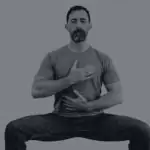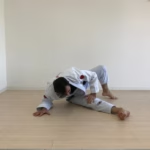Breathing practice has a strange reputation.
Some people treat it like a miracle cure. Others say it’s the secret hack to peak performance, without ever explaining how. And many assume it’s just related to meditation or a relaxation technique with no carryover to real training.
But the truth of it is pretty straightforward.
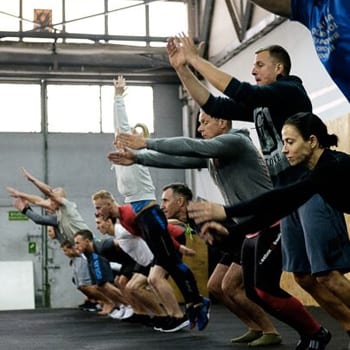 Breath control can help with your performance. Not because it changes your personality and turns you into a zen monk, but because it gives you more control over how your body responds to effort. And when practiced regularly, it reduces the anxiety and guesswork around how best to breathe when things get tough.
Breath control can help with your performance. Not because it changes your personality and turns you into a zen monk, but because it gives you more control over how your body responds to effort. And when practiced regularly, it reduces the anxiety and guesswork around how best to breathe when things get tough.
That alone is incredibly helpful because what we hear from people isn’t that they don’t know why improving their breathing is important, but it’s what exactly they should do with that information.
Exactly How to breathe for Exercise Performance and Recovery
Here’s Ryan with the specifics about how to breathe during and after training:
Breath control is a skill.
And just like any other skill it needs to be learned and practiced for you to get better at it. Like learning to coordinate your breath during a tough movement; timing your exhale with effort, staying relaxed under pressure, or simply staying consistent when fatigue hits.
These aren’t things that just happen, you need consistent exposure and repetition.
What Breath Control Actually Does for Performance
There are three areas where better breath control makes a real difference, especially when the effort ramps up and things start to feel chaotic.
1. Breath Efficiency and Energy Control
It’s very common for people to brace and burn energy they don’t need to, especially when things get tougher to do. Proper breath control changes that. With practice, you’ll recognize when you’re creating unnecessary tension and move with more efficiency.
That means better endurance without extra effort!
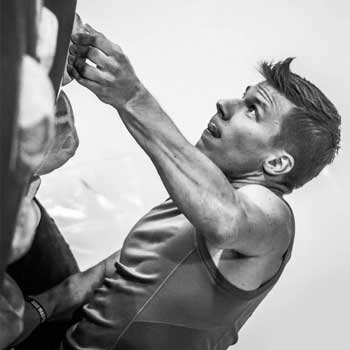 Controlled breathing patterns also condition your diaphragm for stronger, more effective breathing. You’ll build tolerance to CO₂, delay fatigue during intense sets, and transition between intensity levels with less struggle.
Controlled breathing patterns also condition your diaphragm for stronger, more effective breathing. You’ll build tolerance to CO₂, delay fatigue during intense sets, and transition between intensity levels with less struggle.
Over time, you’ll find yourself with more stamina and less gasping for air.
2. Enhanced Autonomic Regulation and Recovery
Controlled breathing gives you more say over your body’s response to high efforts. Your breath is one of the few levers you can consciously pull to influence your autonomic nervous system. For example, slowing down your exhale helps shift you into a parasympathetic (rest and recover) state.
This improved regulation can lower your perceived effort both during activity and in the recovery phases between sets. In practical terms, this means you bounce back quicker, feel less taxed, and get more quality out of every session.
In addition, after your workout is done you’ll transition into the parasympathetic state more quickly. This is our body’s “recovery mode”, so that your downtime is truly restorative. This helps you to be more ready to pour energy into the next session.
3. Mental Focus, Stress Tolerance and Resilience
When effort ramps up, your ability to stay calm and focused can mean the difference between success and failure. Breath practice helps you stay sharp under pressure, making you less reactive and more composed.
With consistent training, you develop sharper focus during challenging sets, lowered anxiety when the intensity spikes, and more self-awareness around breakdown and fatigue. This shows up when you’re right in the middle of grinding out a rep and feel your form slipping, or when your heart’s racing but you still need to keep your pacing.
Breath control gives you the awareness and stability to respond instead of panic. This ability to adjust appropriately is a resilience that will show up in your workouts and beyond.
Together, these three benefits help you train harder, recover faster, and stay composed under pressure, without second-guessing your breath.
How Untrained Breathing Undermines Your Performance
 Everyone breathes, if you didn’t you’d be dead. Yet that doesn’t mean everyone breathes well, especially when effort ramps up.
Everyone breathes, if you didn’t you’d be dead. Yet that doesn’t mean everyone breathes well, especially when effort ramps up.
When things get tough, most people default to shallow, reactive breathing. They breathe through their mouths too early, clamp down their ribs and tighten their abs. This accelerates fatigue and prematurely saps your endurance.
And then there are the more subtle issues:
- Difficulty maintaining appropriate breathing patterns
- Struggling to breathe in proper sync with movement or transitions
- Feeling like there’s a “right” way to breathe but not being able to keep it up
These are common. And more often than not, they’re less about doing it wrong and more about not having enough reps under your belt. That’s why you need consistent breath training. Breath control is a skill and like any skill, it takes time, patience, and consistent practice.
That’s why your approach has to be something you can actually stick with, because discomfort and awkwardness are part of the learning curve. And some of what feels like a problem is just your awareness catching up to your practice. That difficulty means that you are learning!
After enough practice, what you’ll likely notice won’t be very dramatic. You’ll feel less anxious about your breath and know what to do when you get winded.
Eventually you’ll trust your breath to support you and what you need to do, and it will be with a lot less effort. So instead of leaving it to trial and error, we built a program that gives you structured, repeatable breathing practice you can actually stick with.
How To Effectively And Permanently Improve Your Breathing For Better Performance and Recovery
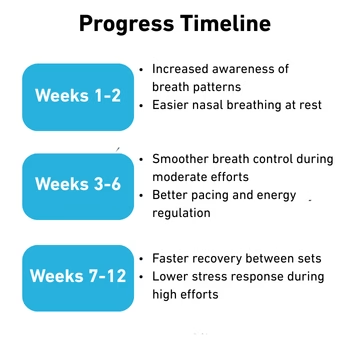 First, you need a practice you’ll actually follow.
First, you need a practice you’ll actually follow.
“Knowing” why breath training matters is a start, but it’s the DOING that makes the difference.
If you want the simplest way to get started now, go ahead and get our Respiration program, but here’s an outline on how best to implement a dedicated breathing practice into your routine.
1. Add it on to your current training
Right before or right after so it becomes a regular part of your practice right away
2. Practice in different positions
This helps you internalize the patterns and build control that transfers to movement.
3. Use light movement to build adaptability
Incorporating fundamental movements trains breath control for when you need it most.
4. Build up as you improve
Just like you don’t lift the same weights forever, your breath practice should also progress over time.
With consistent practice, you’ll notice results within a couple of weeks, but it’s the 8 to 12 mark where gains really start to lock in. That’s when your nervous system adapts and those gains in control and confidence become part of how you move.
Don’t stress about time, even five minutes of focused training makes a big difference.
The biggest changes happen between doing nothing and doing something! And when you do have more time, longer sessions of 10 to 15 minutes can accelerate the process by helping you settle into a rhythm and deepen the effects.
This is exactly how Respiration is structured, so you can just pick how long you want to practice for the day and hit “start.”
Training Your Breathing For Better Performance
Most breathwork advice stops at telling you what to do, while Respiration actually helps you do it. With short, structured sessions and built-in progression, you’ll finally have a way to practice that’s consistent, repeatable, and doable even on your busiest days.



